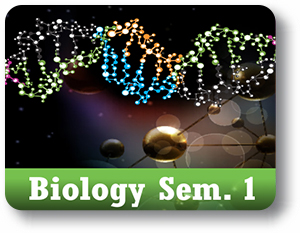Biology Semester 1 (LAB)

Course Overview:
This course explains the basics of science and biology. Students learn about prokaryotic and eukaryotic cells and cellular components and structures that enable them to carry out life functions such as photosynthesis and respiration. Students learn about the difference between a cell and a virus. Students learn about the relevance and applications of DNA which is coded and organized into genes in chromosomes, proteins and amino acids. The course also details the biodiversity in our environment and Natural Selection leading to this biodiversity. The course details the interaction between technological development and the society. The course presents a case study on Antibiotics, their importance, development and history.
Note: This course is not designed for ELL (English Language Learners) students. ELL students may enroll in this course ONLY if they have adequate mentor support at their home school and are able to fulfill all course requirements.
Prerequisites:
Middle School ScienceRequired Materials:
- Fresh White carnation flowers with stems
- Water
- Clear glass cup
- Food coloring – blue, red, yellow
- Teaspoon
- Ruler
- Measuring Cup
- Scissors
- Potatoes
- Knife
- Sugar
- Salt
- Strawberries
- Aloe Vera Juice
- Antibacterial hand wash liquid soap
- Paper towels
- Sandwich zip lock bags
- Tongs
- Sticky notes
- Magnifying Glass
- A sheet to record data (lab sheet)
Syllabus:
Section 1: Introduction to Science and Biology
- Introduction to Science
- Scientific Methods
- Scientific Investigation
- Introduction to Biology
- Laboratory and Safety
Section 2: The Cell – Structure and Function
- Life Functions
- The Cell
- Cellular Components
- Cellular Respiration
- Chemical Reactions in Cell
- Cellular Transport
- Nutrition
- Organic Molecules
Section 3: Genetics
- Introduction to Genetics
- Proteins and Enzymes
- Gene Expression and Genetic Code
- The Cell Cycle
- Fertilization and Reproduction
- Mendel’s Principle of Inheritance
- Introduction to Genetic Mutation
- Survival of Species
Section 4: Biodiversity and Natural Selection
- Biodiversity
- Biological Evolution
- Natural Selection
- Natural Selections- Adaptations
- Group Behavior and Fossil Records
Section 5: Case Study Antibiotics – Science, Technology and Society
- Science, Technology and Society
- The History and Scientific Development of Antiobiotics
- The Industrial Process of the Design and Manufacture of Antibiotics
- Antibiotic Resistance and Current Treatments


